Pumping Station Desing - Second Edition by Robert L. Sanks, George Tchobahoglous, Garr M. Jones
Подождите немного. Документ загружается.

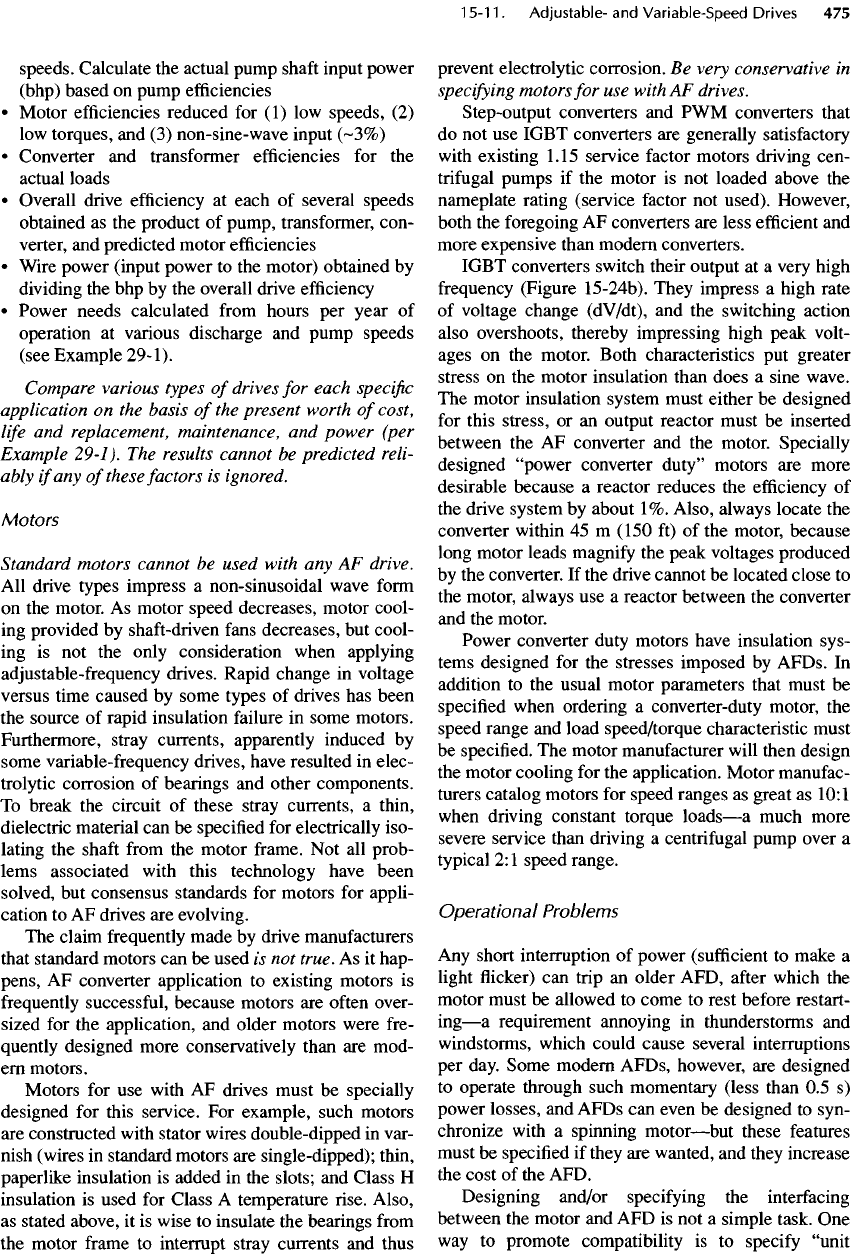
speeds.
Calculate
the
actual pump
shaft
input power
(bhp)
based
on
pump
efficiencies
•
Motor
efficiencies
reduced
for (1) low
speeds,
(2)
low
torques,
and (3)
non-sine-wave input
(-3%)
•
Converter
and
transformer
efficiencies
for the
actual loads
•
Overall drive
efficiency
at
each
of
several speeds
obtained
as the
product
of
pump, transformer, con-
verter,
and
predicted
motor
efficiencies
•
Wire power (input power
to the
motor) obtained
by
dividing
the bhp by the
overall drive
efficiency
•
Power needs calculated
from
hours
per
year
of
operation
at
various discharge
and
pump speeds
(see Example
29-1).
Compare
various
types
of
drives
for
each
specific
application
on the
basis
of the
present worth
of
cost,
life
and
replacement,
maintenance,
and
power (per
Example
29-1).
The
results
cannot
be
predicted
reli-
ably
if
any
of
these factors
is
ignored.
Motors
Standard
motors cannot
be
used with
any AF
drive.
All
drive types impress
a
non-sinusoidal wave
form
on
the
motor.
As
motor speed decreases, motor
cool-
ing
provided
by
shaft-driven
fans
decreases,
but
cool-
ing
is not the
only consideration when applying
adjustable-frequency
drives. Rapid change
in
voltage
versus
time caused
by
some types
of
drives
has
been
the
source
of
rapid insulation
failure
in
some motors.
Furthermore, stray currents, apparently induced
by
some variable-frequency drives, have resulted
in
elec-
trolytic corrosion
of
bearings
and
other components.
To
break
the
circuit
of
these stray currents,
a
thin,
dielectric
material
can be
specified
for
electrically iso-
lating
the
shaft
from
the
motor
frame.
Not all
prob-
lems associated with this technology have been
solved,
but
consensus standards
for
motors
for
appli-
cation
to AF
drives
are
evolving.
The
claim frequently made
by
drive manufacturers
that
standard motors
can be
used
is not
true.
As it
hap-
pens,
AF
converter application
to
existing motors
is
frequently
successful, because motors
are
often
over-
sized
for the
application,
and
older motors were fre-
quently
designed more conservatively than
are
mod-
ern
motors.
Motors
for use
with
AF
drives must
be
specially
designed
for
this service.
For
example, such motors
are
constructed with stator wires double-dipped
in
var-
nish (wires
in
standard motors
are
single-dipped); thin,
paperlike insulation
is
added
in the
slots;
and
Class
H
insulation
is
used
for
Class
A
temperature
rise.
Also,
as
stated above,
it is
wise
to
insulate
the
bearings
from
the
motor
frame
to
interrupt stray currents
and
thus
prevent electrolytic corrosion.
Be
very
conservative
in
specifying
motors
for use
with
AF
drives.
Step-output converters
and PWM
converters that
do not use
IGBT converters
are
generally satisfactory
with
existing
1.15
service
factor
motors driving cen-
trifugal
pumps
if the
motor
is not
loaded above
the
nameplate rating (service
factor
not
used). However,
both
the
foregoing
AF
converters
are
less
efficient
and
more expensive than modern converters.
IGBT converters switch their output
at a
very high
frequency
(Figure
15-24b).
They impress
a
high rate
of
voltage change (dV/dt),
and the
switching action
also overshoots, thereby impressing high peak volt-
ages
on the
motor. Both characteristics
put
greater
stress
on the
motor insulation than does
a
sine wave.
The
motor insulation system must either
be
designed
for
this stress,
or an
output reactor must
be
inserted
between
the AF
converter
and the
motor. Specially
designed
"power
converter duty" motors
are
more
desirable
because
a
reactor
reduces
the
efficiency
of
the
drive system
by
about
1%.
Also, always locate
the
converter within
45 m
(150
ft) of the
motor, because
long motor leads
magnify
the
peak voltages produced
by
the
converter.
If the
drive cannot
be
located
close
to
the
motor, always
use a
reactor between
the
converter
and
the
motor.
Power converter duty motors have insulation sys-
tems designed
for the
stresses imposed
by
AFDs.
In
addition
to the
usual motor parameters that must
be
specified
when
ordering
a
converter-duty motor,
the
speed
range
and
load speed/torque
characteristic
must
be
specified.
The
motor manufacturer will then design
the
motor cooling
for the
application. Motor
manufac-
turers catalog motors
for
speed ranges
as
great
as
10:1
when
driving constant torque
loads
—
a
much more
severe service than driving
a
centrifugal pump over
a
typical
2:1
speed range.
Operational Problems
Any
short interruption
of
power
(sufficient
to
make
a
light
flicker) can
trip
an
older AFD,
after
which
the
motor must
be
allowed
to
come
to
rest before restart-
ing
—
a
requirement annoying
in
thunderstorms
and
windstorms,
which could cause several interruptions
per
day. Some modern AFDs, however,
are
designed
to
operate
through such momentary (less than
0.5 s)
power
losses,
and
AFDs
can
even
be
designed
to
syn-
chronize with
a
spinning
motor
—
but
these
features
must
be
specified
if
they
are
wanted,
and
they increase
the
cost
of the
AFD.
Designing and/or specifying
the
interfacing
between
the
motor
and AFD is not a
simple task.
One
way
to
promote compatibility
is to
specify
"unit
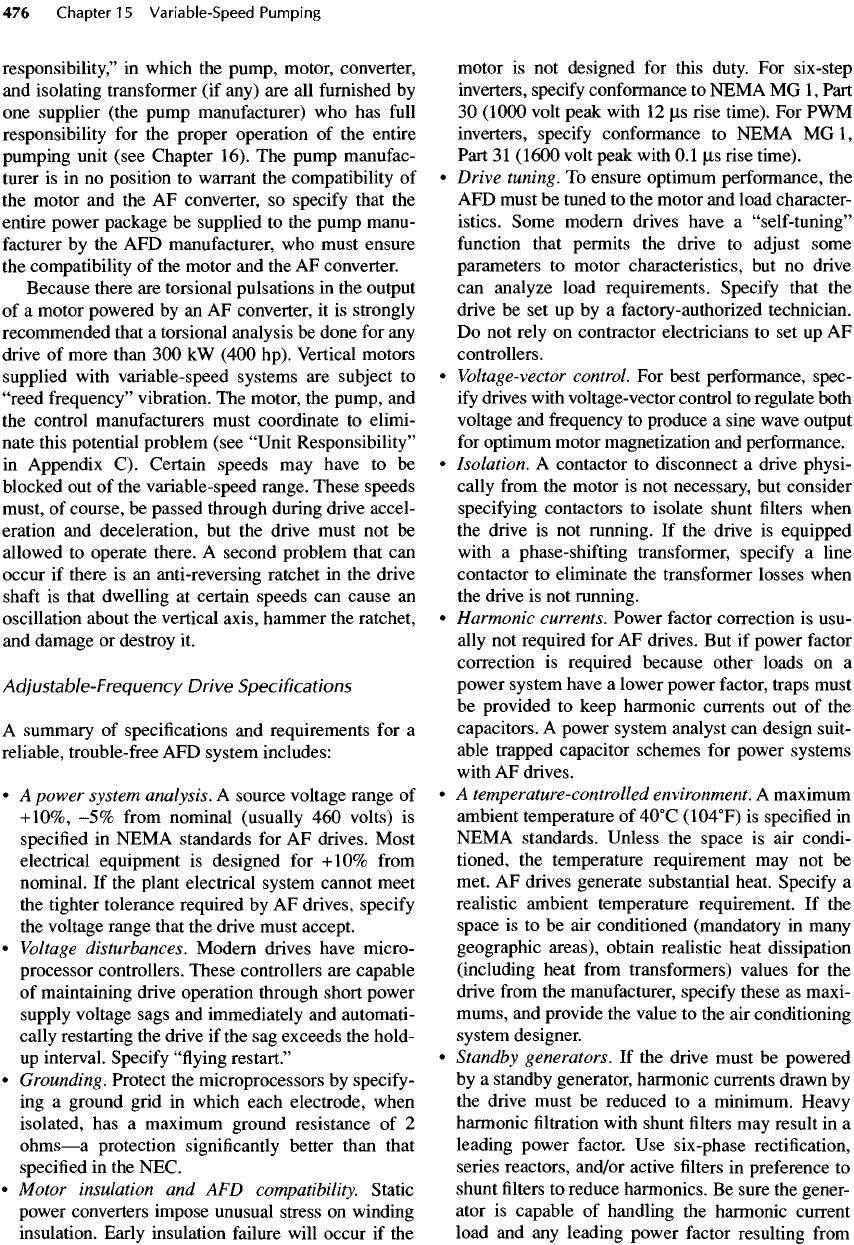
responsibility,"
in
which
the
pump, motor, converter,
and
isolating transformer
(if
any)
are all
furnished
by
one
supplier (the pump manufacturer)
who has
full
responsibility
for the
proper operation
of the
entire
pumping
unit (see Chapter 16).
The
pump manufac-
turer
is in no
position
to
warrant
the
compatibility
of
the
motor
and the AF
converter,
so
specify that
the
entire
power package
be
supplied
to the
pump manu-
facturer
by the AFD
manufacturer,
who
must ensure
the
compatibility
of the
motor
and the AF
converter.
Because there
are
torsional pulsations
in the
output
of
a
motor powered
by an AF
converter,
it is
strongly
recommended that
a
torsional analysis
be
done
for any
drive
of
more than
300 kW
(400 hp). Vertical motors
supplied with variable-speed systems
are
subject
to
"reed
frequency" vibration.
The
motor,
the
pump,
and
the
control manufacturers must coordinate
to
elimi-
nate this potential problem (see "Unit Responsibility"
in
Appendix
C).
Certain speeds
may
have
to be
blocked
out of the
variable-speed range. These speeds
must,
of
course,
be
passed through during drive accel-
eration
and
deceleration,
but the
drive must
not be
allowed
to
operate there.
A
second problem that
can
occur
if
there
is an
anti-reversing ratchet
in the
drive
shaft
is
that dwelling
at
certain speeds
can
cause
an
oscillation about
the
vertical axis, hammer
the
ratchet,
and
damage
or
destroy
it.
Adjustable-Frequency
Drive
Specifications
A
summary
of
specifications
and
requirements
for a
reliable, trouble-free
AFD
system includes:
• A
power system analysis.
A
source voltage range
of
+10%,
-5%
from
nominal (usually
460
volts)
is
specified
in
NEMA standards
for AF
drives. Most
electrical equipment
is
designed
for
+10%
from
nominal.
If the
plant electrical system cannot meet
the
tighter tolerance required
by AF
drives,
specify
the
voltage range that
the
drive must accept.
•
Voltage
disturbances. Modern drives have micro-
processor controllers. These controllers
are
capable
of
maintaining drive operation through short power
supply
voltage sags
and
immediately
and
automati-
cally
restarting
the
drive
if the sag
exceeds
the
hold-
up
interval.
Specify
"flying
restart."
•
Grounding. Protect
the
microprocessors
by
specify-
ing
a
ground grid
in
which each electrode, when
isolated,
has a
maximum ground resistance
of 2
ohms
—
a
protection
significantly
better than that
specified
in the
NEC.
•
Motor insulation
and AFD
compatibility.
Static
power converters impose unusual stress
on
winding
insulation. Early insulation
failure
will occur
if the
motor
is not
designed
for
this duty.
For
six-step
inverters,
specify
conformance
to
NEMA
MG
1,
Part
30
(1000 volt peak with
12
jus
rise
time).
For PWM
inverters, specify conformance
to
NEMA
MG
1,
Part
31
(1600 volt peak with
0.1
JLIS
rise
time).
•
Drive tuning.
To
ensure optimum performance,
the
AFD
must
be
tuned
to the
motor
and
load character-
istics.
Some modern drives have
a
"self-tuning"
function
that permits
the
drive
to
adjust
some
parameters
to
motor characteristics,
but no
drive
can
analyze load requirements. Specify that
the
drive
be set up by a
factory-authorized technician.
Do not
rely
on
contractor electricians
to set up AF
controllers.
•
Voltage-vector
control.
For
best performance, spec-
ify
drives with voltage-vector control
to
regulate both
voltage
and
frequency
to
produce
a
sine wave output
for
optimum motor magnetization
and
performance.
•
Isolation.
A
contactor
to
disconnect
a
drive physi-
cally
from
the
motor
is not
necessary,
but
consider
specifying
contactors
to
isolate shunt
filters
when
the
drive
is not
running.
If the
drive
is
equipped
with
a
phase-
shifting
transformer,
specify
a
line
contactor
to
eliminate
the
transformer losses when
the
drive
is not
running.
•
Harmonic currents. Power factor correction
is
usu-
ally
not
required
for AF
drives.
But if
power factor
correction
is
required because other loads
on a
power system have
a
lower power factor, traps must
be
provided
to
keep
harmonic currents
out of the
capacitors.
A
power system analyst
can
design suit-
able trapped capacitor schemes
for
power systems
with
AF
drives.
• A
temperature-controlled environment.
A
maximum
ambient temperature
of
4O
0
C
(104
0
F)
is
specified
in
NEMA standards. Unless
the
space
is air
condi-
tioned,
the
temperature requirement
may not be
met.
AF
drives generate substantial heat. Specify
a
realistic ambient temperature requirement.
If the
space
is to be air
conditioned (mandatory
in
many
geographic areas), obtain realistic heat dissipation
(including
heat
from
transformers) values
for the
drive
from
the
manufacturer,
specify
these
as
maxi-
mums,
and
provide
the
value
to the air
conditioning
system
designer.
•
Standby generators.
If the
drive must
be
powered
by
a
standby generator, harmonic currents drawn
by
the
drive must
be
reduced
to a
minimum. Heavy
harmonic
filtration
with shunt
filters may
result
in a
leading power
factor.
Use
six-phase rectification,
series
reactors, and/or active
filters in
preference
to
shunt
filters to
reduce harmonics.
Be
sure
the
gener-
ator
is
capable
of
handling
the
harmonic current
load
and any
leading power factor resulting
from
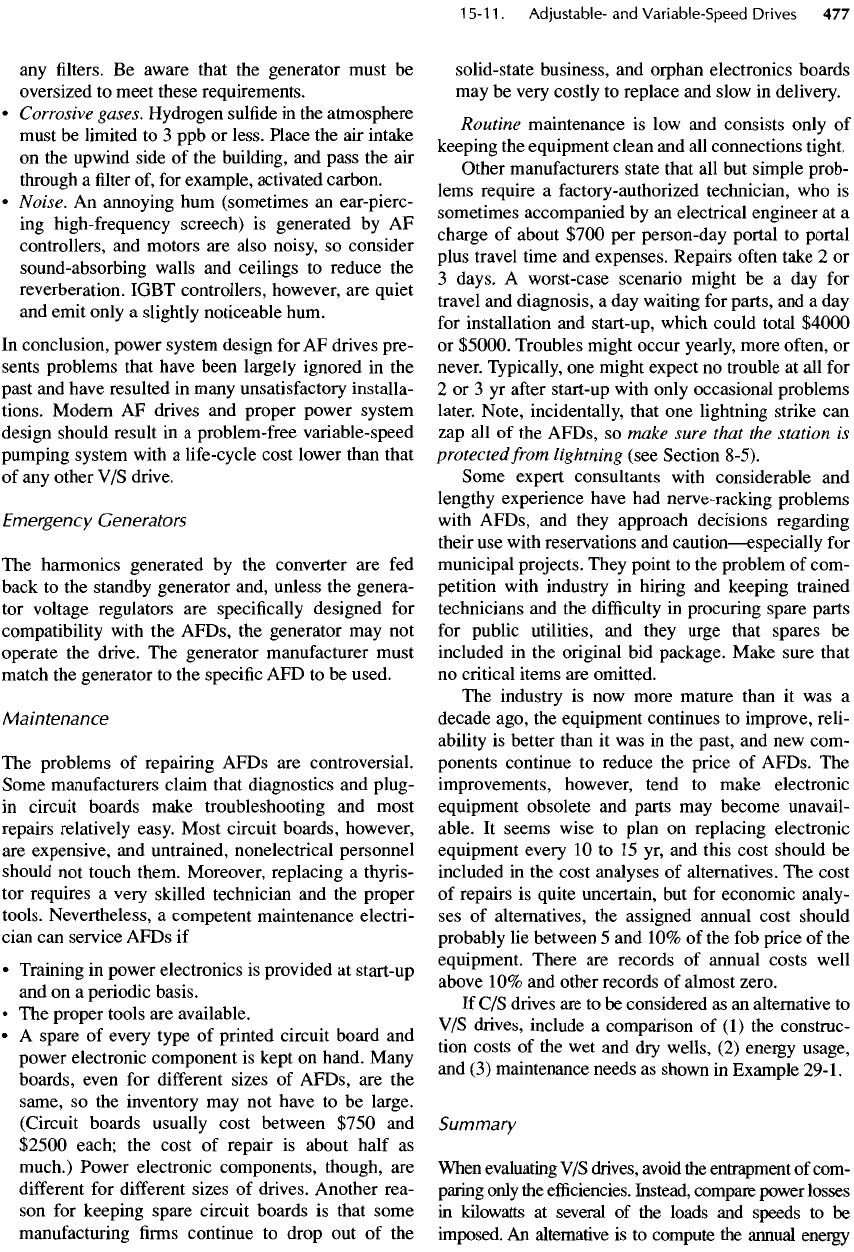
any
filters. Be
aware that
the
generator must
be
oversized
to
meet these requirements.
•
Corrosive
gases. Hydrogen
sulfide
in the
atmosphere
must
be
limited
to 3 ppb or
less. Place
the air
intake
on
the
upwind side
of the
building,
and
pass
the air
through
a filter of, for
example, activated carbon.
•
Noise.
An
annoying
hum
(sometimes
an
ear-pierc-
ing
high-frequency
screech)
is
generated
by AF
controllers,
and
motors
are
also noisy,
so
consider
sound-absorbing
walls
and
ceilings
to
reduce
the
reverberation. IGBT controllers, however,
are
quiet
and
emit only
a
slightly noticeable hum.
In
conclusion, power system design
for AF
drives pre-
sents
problems that have been largely ignored
in the
past
and
have resulted
in
many unsatisfactory installa-
tions. Modern
AF
drives
and
proper power system
design should result
in a
problem-free
variable-
speed
pumping
system with
a
life-cycle cost lower than that
of
any
other
V/S
drive.
Emergency
Generators
The
harmonics generated
by the
converter
are fed
back
to the
standby generator and, unless
the
genera-
tor
voltage regulators
are
specifically
designed
for
compatibility with
the
AFDs,
the
generator
may not
operate
the
drive.
The
generator
manufacturer
must
match
the
generator
to the
specific
AFD to be
used.
Maintenance
The
problems
of
repairing AFDs
are
controversial.
Some
manufacturers
claim that diagnostics
and
plug-
in
circuit boards make troubleshooting
and
most
repairs relatively easy. Most circuit boards, however,
are
expensive,
and
untrained, nonelectrical personnel
should
not
touch them. Moreover, replacing
a
thyris-
tor
requires
a
very skilled technician
and the
proper
tools. Nevertheless,
a
competent maintenance electri-
cian
can
service AFDs
if
•
Training
in
power electronics
is
provided
at
start-up
and
on a
periodic basis.
• The
proper tools
are
available.
• A
spare
of
every type
of
printed circuit board
and
power electronic component
is
kept
on
hand. Many
boards, even
for
different
sizes
of
AFDs,
are the
same,
so the
inventory
may not
have
to be
large.
(Circuit
boards
usually
cost between
$750
and
$2500
each;
the
cost
of
repair
is
about half
as
much.)
Power electronic components, though,
are
different
for
different
sizes
of
drives. Another rea-
son
for
keeping spare circuit boards
is
that some
manufacturing
firms
continue
to
drop
out of the
solid-state business,
and
orphan electronics boards
may
be
very costly
to
replace
and
slow
in
delivery.
Routine maintenance
is low and
consists only
of
keeping
the
equipment clean
and all
connections tight.
Other manufacturers state that
all but
simple prob-
lems require
a
factory-authorized technician,
who is
sometimes accompanied
by an
electrical
engineer
at a
charge
of
about
$700
per
person-day portal
to
portal
plus travel time
and
expenses. Repairs
often
take
2 or
3
days.
A
worst-case scenario might
be a day for
travel
and
diagnosis,
a day
waiting
for
parts,
and a day
for
installation
and
start-up, which could total
$4000
or
$5000.
Troubles might occur yearly, more
often,
or
never. Typically,
one
might expect
no
trouble
at all for
2 or 3 yr
after
start-up with only occasional problems
later. Note, incidentally, that
one
lightning strike
can
zap all of the
AFDs,
so
make
sure
that
the
station
is
protected
from
lightning (see Section 8-5).
Some expert consultants with considerable
and
lengthy
experience have
had
nerve-racking problems
with
AFDs,
and
they approach decisions regarding
their
use
with reservations
and
caution
—
especially
for
municipal projects. They
point
to the
problem
of
com-
petition with industry
in
hiring
and
keeping trained
technicians
and the
difficulty
in
procuring spare parts
for
public utilities,
and
they urge that spares
be
included
in the
original
bid
package. Make sure that
no
critical
items
are
omitted.
The
industry
is now
more mature than
it was a
decade ago,
the
equipment continues
to
improve,
reli-
ability
is
better than
it was in the
past,
and new
com-
ponents continue
to
reduce
the
price
of
AFDs.
The
improvements, however, tend
to
make electronic
equipment
obsolete
and
parts
may
become unavail-
able.
It
seems wise
to
plan
on
replacing electronic
equipment every
10 to 15 yr, and
this cost should
be
included
in the
cost analyses
of
alternatives.
The
cost
of
repairs
is
quite uncertain,
but for
economic analy-
ses
of
alternatives,
the
assigned annual cost should
probably
lie
between
5 and 10% of the fob
price
of the
equipment.
There
are
records
of
annual costs well
above
10% and
other records
of
almost zero.
If
C/S
drives
are to be
considered
as an
alternative
to
V/S
drives, include
a
comparison
of (1) the
construc-
tion
costs
of the wet and dry
wells,
(2)
energy usage,
and
(3)
maintenance needs
as
shown
in
Example
29-1.
Summary
When
evaluating
V/S
drives, avoid
the
entrapment
of
com-
paring
only
the
efficiencies.
Instead, compare power losses
in
kilowatts
at
several
of the
loads
and
speeds
to be
imposed.
An
alternative
is to
compute
the
annual energy
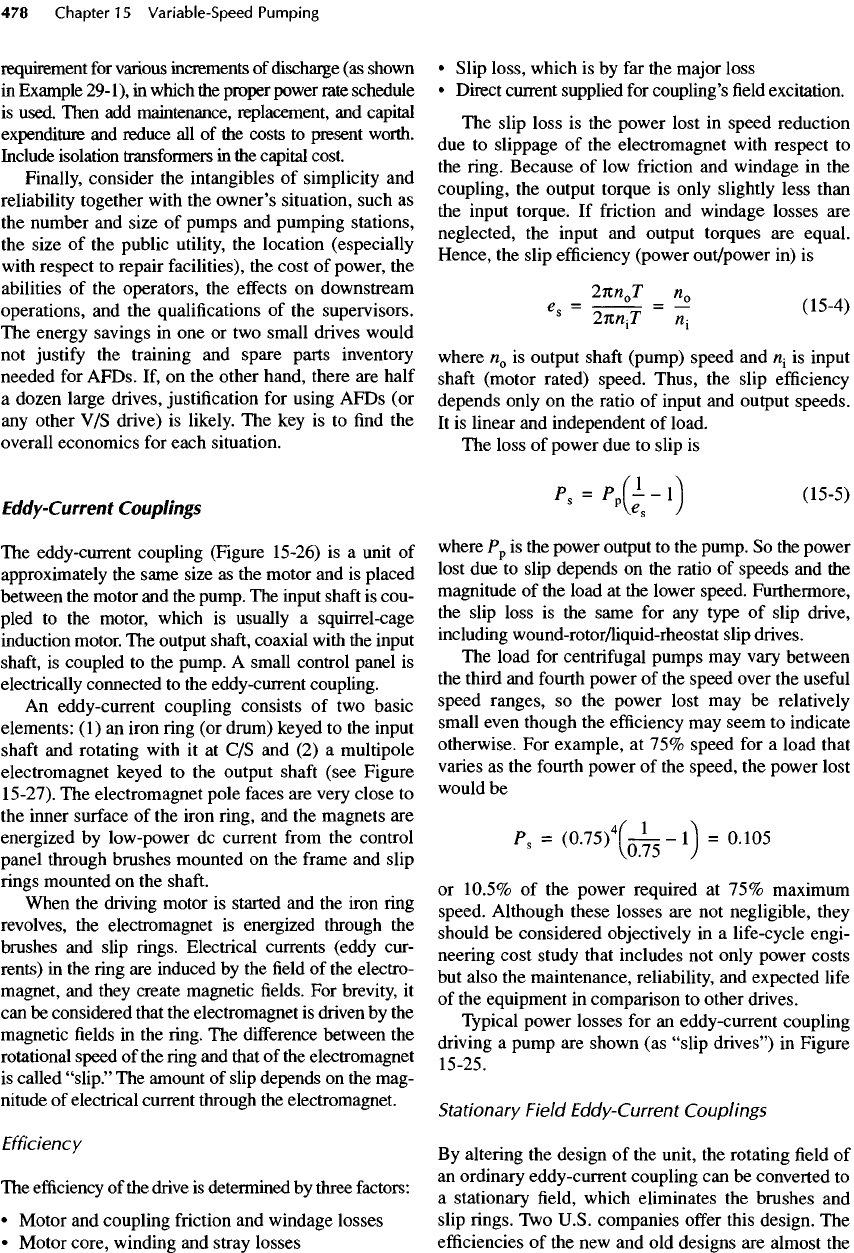
requirement
for
various increments
of
discharge
(as
shown
in
Example
29-1),
in
which
the
proper power rate schedule
is
used. Then
add
maintenance, replacement,
and
capital
expenditure
and
reduce
all of the
costs
to
present
worth.
Include isolation
transformers
in the
capital cost.
Finally, consider
the
intangibles
of
simplicity
and
reliability together with
the
owner's situation, such
as
the
number
and
size
of
pumps
and
pumping stations,
the
size
of the
public utility,
the
location (especially
with
respect
to
repair
facilities),
the
cost
of
power,
the
abilities
of the
operators,
the
effects
on
downstream
operations,
and the
qualifications
of the
supervisors.
The
energy savings
in one or two
small drives would
not
justify
the
training
and
spare parts inventory
needed
for
AFDs.
If, on the
other hand, there
are
half
a
dozen large drives, justification
for
using AFDs
(or
any
other
V/S
drive)
is
likely.
The key is to find the
overall economics
for
each
situation.
Eddy-Current
Couplings
The
eddy-current coupling (Figure
15-26)
is a
unit
of
approximately
the
same size
as the
motor
and is
placed
between
the
motor
and the
pump.
The
input
shaft
is
cou-
pled
to the
motor, which
is
usually
a
squirrel-cage
induction
motor.
The
output
shaft,
coaxial with
the
input
shaft,
is
coupled
to the
pump.
A
small control panel
is
electrically connected
to the
eddy-current coupling.
An
eddy-current coupling consists
of two
basic
elements:
(1)
an
iron
ring (or
drum) keyed
to the
input
shaft
and
rotating with
it at C/S and (2) a
multipole
electromagnet keyed
to the
output
shaft
(see Figure
15-27).
The
electromagnet pole
faces
are
very close
to
the
inner surface
of the
iron ring,
and the
magnets
are
energized
by
low-power
dc
current
from
the
control
panel through brushes mounted
on the
frame
and
slip
rings mounted
on the
shaft.
When
the
driving motor
is
started
and the
iron ring
revolves,
the
electromagnet
is
energized through
the
brushes
and
slip
rings.
Electrical currents (eddy cur-
rents)
in the ring are
induced
by the field of the
electro-
magnet,
and
they create magnetic
fields. For
brevity,
it
can
be
considered that
the
electromagnet
is
driven
by the
magnetic
fields in the ring. The
difference
between
the
rotational speed
of the ring and
that
of the
electromagnet
is
called
"slip."
The
amount
of
slip depends
on the
mag-
nitude
of
electrical current through
the
electromagnet.
Efficiency
The
efficiency
of the
drive
is
determined
by
three factors:
•
Motor
and
coupling
friction
and
windage losses
•
Motor core, winding
and
stray losses
•
Slip
loss,
which
is by far the
major
loss
•
Direct current supplied
for
coupling's
field
excitation.
The
slip
loss
is the
power
lost
in
speed
reduction
due to
slippage
of the
electromagnet with
respect
to
the ring.
Because
of low
friction
and
windage
in the
coupling,
the
output torque
is
only slightly less than
the
input torque.
If
friction
and
windage
losses
are
neglected,
the
input
and
output torques
are
equal.
Hence,
the
slip
efficiency
(power out/power
in) is
e
s
=
f
^
1
,
=
"°
(15-4)
2Tt^r
H
1
where
n
0
is
output
shaft
(pump) speed
and
n
{
is
input
shaft
(motor rated)
speed.
Thus,
the
slip
efficiency
depends only
on the
ratio
of
input
and
output
speeds.
It
is
linear
and
independent
of
load.
The
loss
of
power
due to
slip
is
/
3
S
=
PP(J-
-l)
(15-5)
where
P
p
is the
power output
to the
pump.
So the
power
lost
due to
slip depends
on the
ratio
of
speeds
and the
magnitude
of the
load
at the
lower speed. Furthermore,
the
slip loss
is the
same
for any
type
of
slip drive,
including
wound-rotor/liquid-rheostat
slip drives.
The
load
for
centrifugal
pumps
may
vary between
the
third
and
fourth
power
of the
speed
over
the
useful
speed ranges,
so the
power lost
may be
relatively
small even though
the
efficiency
may
seem
to
indicate
otherwise.
For
example,
at 75%
speed
for a
load that
varies
as the
fourth
power
of the
speed,
the
power lost
would
be
PS
=
(0
'
15)4
(&75~
1
}
=
ai
°
5
or
10.5%
of the
power required
at 75%
maximum
speed.
Although these losses
are not
negligible, they
should
be
considered objectively
in a
life-cycle engi-
neering cost study that includes
not
only power costs
but
also
the
maintenance, reliability,
and
expected
life
of
the
equipment
in
comparison
to
other drives.
Typical power
losses
for an
eddy-current coupling
driving
a
pump
are
shown
(as
"slip
drives")
in
Figure
15-25.
Stationary
Field
Eddy-Current Couplings
By
altering
the
design
of the
unit,
the
rotating
field of
an
ordinary eddy-current coupling
can be
converted
to
a
stationary
field,
which eliminates
the
brushes
and
slip
rings. Two
U.S. companies
offer
this design.
The
efficiencies
of the new and old
designs
are
almost
the
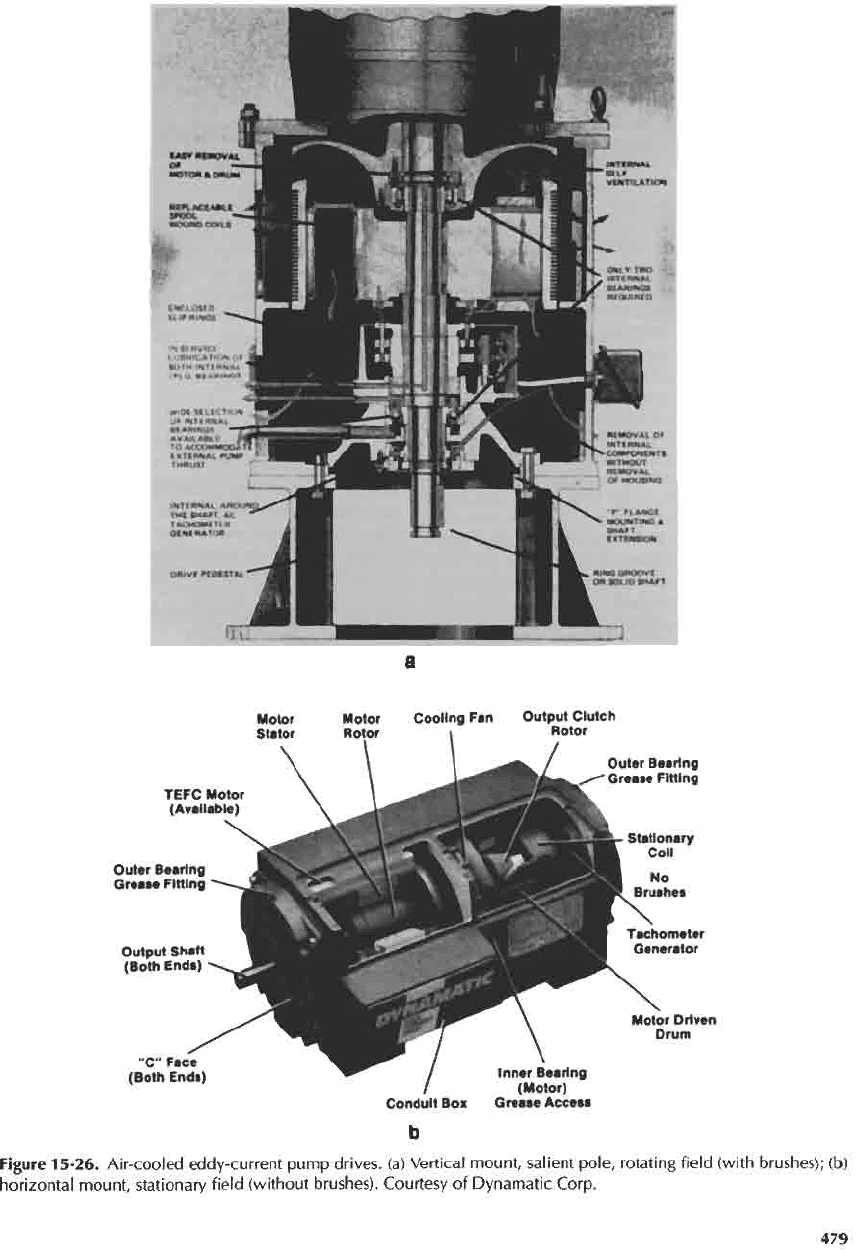
Figure
15-26. Air-cooled eddy-current pump
drives,
(a)
Vertical
mount,
salient
pole,
rotating field (with
brushes);
(b)
horizontal
mount,
stationary
field (without
brushes).
Courtesy
of
Dynamatic Corp.

same
and the
prices
are
comparable,
but
eliminating
the
slip rings
and
brushes reduces
the
maintenance
to
an
amount comparable with
a
squirrel-cage induction
motor.
Liquid
Rheostats
A
complete drive consists
of a
liquid rheostat with
short electric power cables connected
to the
brushes
of
a
wound-rotor motor.
Operation
The
slope
of the
speed—
torque
curve
of an
induction
motor varies with changes
in the
resistance
of the
rotor circuit.
The
lower portions
of the
speed-torque
curves
of any
induction motor
are
shown
in
Figure
15-28
for
many values
of
external resistance
in the
rotor circuit,
and a
portion
of the
speed-torque
curve
of a
typical centrifugal pump
in a
typical
sys-
tem
is
superimposed
on the
motor
speed-torque
curves.
At
any
given speed,
the
motor
and
pump must
operate
at the
intersection
of the
pump
and
motor
speed-torque
curves.
If the
resistance
is
decreased,
the
slope
of the
motor torque curve
is
increased,
which
causes
the
motor
to
accelerate
on its
curve
(while
the
pump
accelerates
on its
curve) until
the
motor
output torque exactly equals
the
torque required
by
the
pump.
A
liquid rheostat
is
basically
a
large, three-phase
resistor. Electrical current
flows
between copper
or
bronze electrodes through
an
electrolyte
(a
very weak
solution
of
distilled water
and
sodium carbonate) that
makes
a
good
and
stable resistor.
The
electrical resis-
tance between electrodes varies inversely with
the
submerged area
of the
electrodes
and
also varies
directly
with
the
distance between
the
electrodes.
The
electrolyte
is the
resistor.
The
resistance
of the
elec-
trodes themselves
is
insignificant.
Pneumatic
Control
The
model most commonly used
for
sewage pumping
is
illustrated
in
Figure
15-29.
One
rheostat
electrode
is
connected
to
each rotor brush
of its
associated motor.
The
principle
of
operation
is
that
of a
manometer.
The
air
pressure,
jP
a
,
in the
sealed reservoir equals
the air
pressure,
P
a
,
at the
bottom
of the
bubbler. This
air
pressure raises
the
level
of the
electrolyte
on the
elec-
trodes
by an
amount,
D. The
depth,
D, in the
rheostat
equals
D in the wet
well
and
also equals
P
a
(expressed
in
height
of
water column).
The air
compressor
is
rela-
tively
small
and
(without storage) supplies
air
directly
to the
piping
as
shown.
The
three-way solenoid valve
vents
the
sealed compartment
to
atmosphere when
the
drive
is
shut down.
The
bubbler requires about
1.7
m
3
/h
(1
ft
3
/min)
of
air at
very
low
pressure,
and an air
compressor pow-
ered
by a
small
(1/4-kW
or
1/4-hp)
motor
is
adequate
for
drivers
up to 600 kW
(800 hp).
Each liquid rheo-
stat
includes
an
internal
air
compressor.
Mechanical
Controls
Another
type
of
liquid rheostat uses movable
and
sta-
tionary
electrodes.
Each
of a set of
upper, movable
electrodes
is
connected
to one of the
motor rotor
brushes
and
stationary, lower electrodes
are
connected
together
to
form
a
wye-connected, three-phase resis-
tor.
The
electrodes
are
fully
submerged
at all
times,
and
resistance between
the
movable
and
stationary
electrodes
is
varied
by
changing
the
level
of the
upper
electrodes. Usually
a
small, single-speed motor
and
sprocket chains
are
used
to
raise
and
lower
the
mov-
able plate assembly.
The
motor receives "up-hold-
down" signals
from
external equipment.
Figure
15-27.
The
principle
of an
eddy-current coupling.
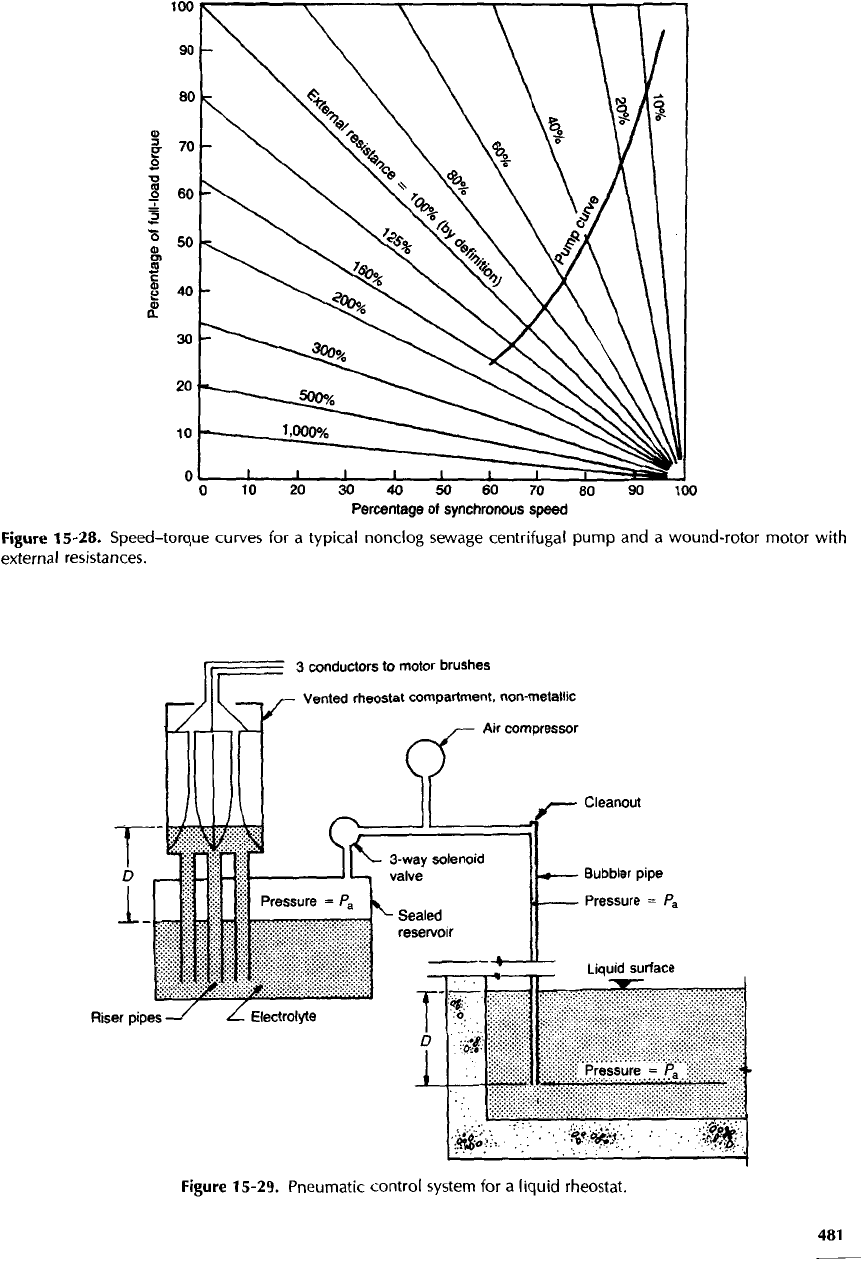
Semal
feSances
ed
"
t0rqUe
^*
**
'
^'
"^
0
'
08
^
8
'
Centn
'
fU8a
'
PUmp
and
a
wou
nd-rotor
motor
with
Figure
15-29.
Pneumatic control
system
for a
liquid
rheostat.
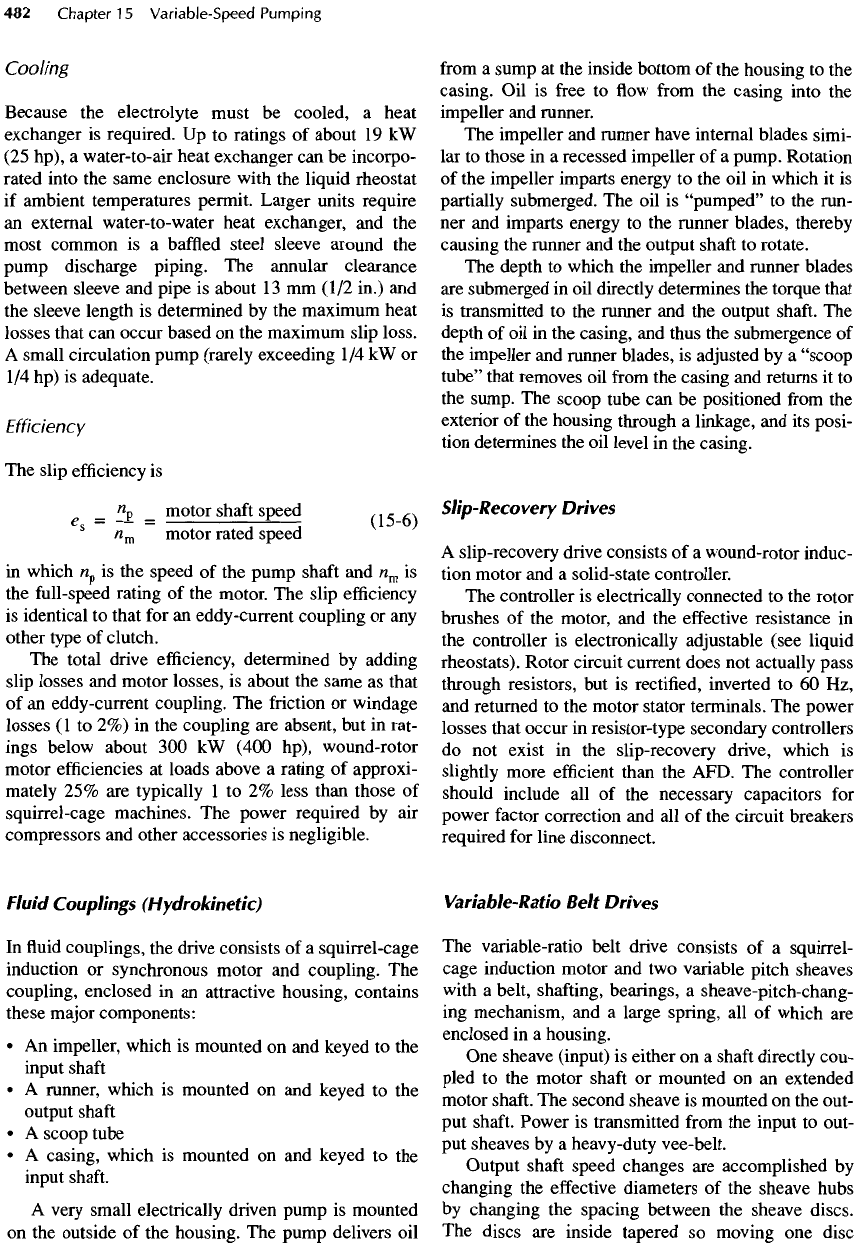
Cooling
Because
the
electrolyte must
be
cooled,
a
heat
exchanger
is
required.
Up to
ratings
of
about
19 kW
(25
hp),
a
water-
to-air
heat
exchanger
can be
incorpo-
rated
into
the
same enclosure with
the
liquid rheostat
if
ambient temperatures permit. Larger units require
an
external water-to-water heat
exchanger,
and the
most
common
is a
baffled
steel sleeve around
the
pump
discharge piping.
The
annular clearance
between sleeve
and
pipe
is
about
13 mm
(1/2 in.)
and
the
sleeve length
is
determined
by the
maximum heat
losses that
can
occur based
on the
maximum slip loss.
A
small circulation pump (rarely exceeding
1/4 kW or
1/4 hp) is
adequate.
Efficiency
The
slip
efficiency
is
_
n
p
_
motor
shaft
speed
H5
6")
s
n
m
motor rated
speed
in
which
n
p
is the
speed
of the
pump
shaft
and
n
m
is
the
full-speed rating
of the
motor.
The
slip
efficiency
is
identical
to
that
for an
eddy-current coupling
or any
other type
of
clutch.
The
total drive
efficiency,
determined
by
adding
slip losses
and
motor losses,
is
about
the
same
as
that
of
an
eddy-current coupling.
The
friction
or
windage
losses
(1 to 2%) in the
coupling
are
absent,
but in
rat-
ings
below about
300 kW
(400 hp), wound-rotor
motor
efficiencies
at
loads above
a
rating
of
approxi-
mately
25% are
typically
1 to 2%
less than those
of
squirrel-cage machines.
The
power required
by air
compressors
and
other accessories
is
negligible.
Fluid
Couplings
(Hydrokinetic)
In
fluid
couplings,
the
drive consists
of a
squirrel-cage
induction
or
synchronous motor
and
coupling.
The
coupling,
enclosed
in an
attractive housing, contains
these
major
components:
• An
impeller, which
is
mounted
on and
keyed
to the
input
shaft
• A
runner, which
is
mounted
on and
keyed
to the
output
shaft
• A
scoop tube
• A
casing, which
is
mounted
on and
keyed
to the
input
shaft.
A
very small electrically driven pump
is
mounted
on
the
outside
of the
housing.
The
pump delivers
oil
from
a
sump
at the
inside bottom
of the
housing
to the
casing.
Oil is
free
to flow
from
the
casing into
the
impeller
and
runner.
The
impeller
and
runner have internal blades simi-
lar
to
those
in a
recessed
impeller
of a
pump.
Rotation
of
the
impeller imparts energy
to the oil in
which
it is
partially submerged.
The oil is
"pumped"
to the
run-
ner and
imparts energy
to the
runner
blades,
thereby
causing
the
runner
and the
output
shaft
to
rotate.
The
depth
to
which
the
impeller
and
runner blades
are
submerged
in oil
directly determines
the
torque that
is
transmitted
to the
runner
and the
output
shaft.
The
depth
of oil in the
casing,
and
thus
the
submergence
of
the
impeller
and
runner blades,
is
adjusted
by a
"scoop
tube" that removes
oil
from
the
casing
and
returns
it to
the
sump.
The
scoop tube
can be
positioned
from
the
exterior
of the
housing through
a
linkage,
and its
posi-
tion
determines
the oil
level
in the
casing.
Slip-Recovery
Drives
A
slip-recovery drive consists
of a
wound-rotor induc-
tion motor
and a
solid-state
controller.
The
controller
is
electrically connected
to the
rotor
brushes
of the
motor,
and the
effective
resistance
in
the
controller
is
electronically
adjustable (see
liquid
rheostats). Rotor circuit current does
not
actually pass
through
resistors,
but is
rectified,
inverted
to 60 Hz,
and
returned
to the
motor
stator
terminals.
The
power
losses that occur
in
resistor-type secondary controllers
do not
exist
in the
slip-recovery drive, which
is
slightly more
efficient
than
the
AFD.
The
controller
should
include
all of the
necessary capacitors
for
power factor correction
and all of the
circuit breakers
required
for
line disconnect.
Variable-Ratio
Belt
Drives
The
variable-ratio belt drive consists
of a
squirrel-
cage induction motor
and two
variable pitch sheaves
with
a
belt,
shafting,
bearings,
a
sheave-pitch-chang-
ing
mechanism,
and a
large spring,
all of
which
are
enclosed
in a
housing.
One
sheave (input)
is
either
on a
shaft
directly cou-
pled
to the
motor
shaft
or
mounted
on an
extended
motor
shaft.
The
second sheave
is
mounted
on the
out-
put
shaft.
Power
is
transmitted
from
the
input
to
out-
put
sheaves
by a
heavy-duty
vee-belt.
Output
shaft
speed changes
are
accomplished
by
changing
the
effective
diameters
of the
sheave hubs
by
changing
the
spacing between
the
sheave discs.
The
discs
are
inside tapered
so
moving
one
disc
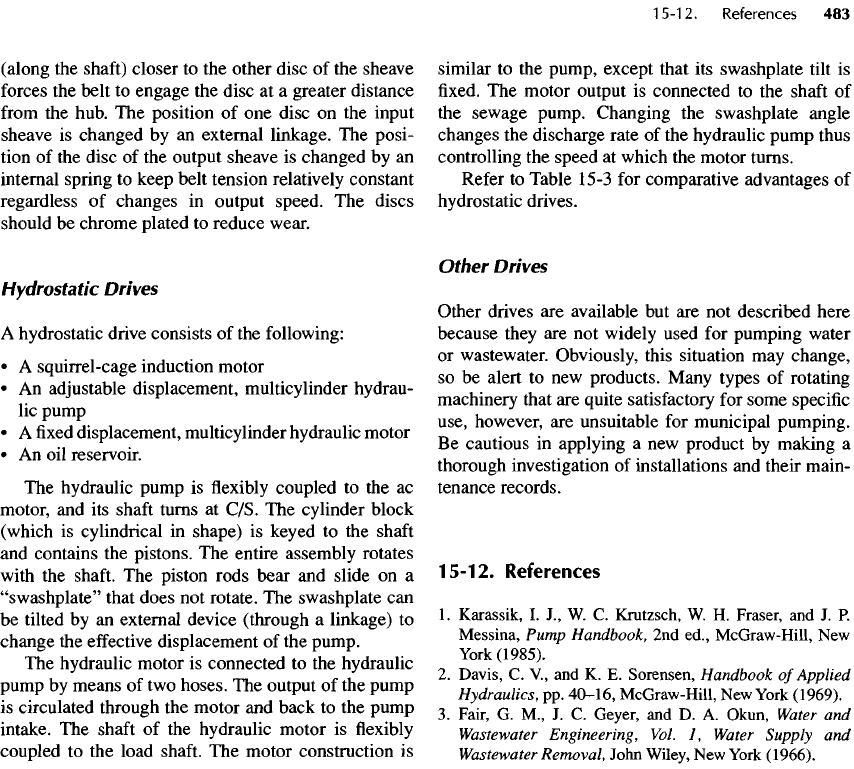
(along
the
shaft)
closer
to the
other disc
of the
sheave
forces
the
belt
to
engage
the
disc
at a
greater distance
from
the
hub.
The
position
of one
disc
on the
input
sheave
is
changed
by an
external linkage.
The
posi-
tion
of the
disc
of the
output sheave
is
changed
by an
internal spring
to
keep belt tension relatively constant
regardless
of
changes
in
output speed.
The
discs
should
be
chrome plated
to
reduce wear.
Hydrostatic
Drives
A
hydrostatic drive consists
of the
following:
• A
squirrel-cage induction motor
• An
adjustable displacement, multicylinder hydrau-
lic
pump
• A fixed
displacement, multicylinder hydraulic motor
• An oil
reservoir.
The
hydraulic pump
is flexibly
coupled
to the ac
motor,
and its
shaft
turns
at
C/S.
The
cylinder block
(which
is
cylindrical
in
shape)
is
keyed
to the
shaft
and
contains
the
pistons.
The
entire assembly rotates
with
the
shaft.
The
piston rods bear
and
slide
on a
"swashplate"
that does
not
rotate.
The
swashplate
can
be
tilted
by an
external device (through
a
linkage)
to
change
the
effective
displacement
of the
pump.
The
hydraulic motor
is
connected
to the
hydraulic
pump
by
means
of two
hoses.
The
output
of the
pump
is
circulated through
the
motor
and
back
to the
pump
intake.
The
shaft
of the
hydraulic motor
is flexibly
coupled
to the
load
shaft.
The
motor construction
is
similar
to the
pump, except that
its
swashplate tilt
is
fixed. The
motor output
is
connected
to the
shaft
of
the
sewage pump. Changing
the
swashplate angle
changes
the
discharge rate
of the
hydraulic pump thus
controlling
the
speed
at
which
the
motor turns.
Refer
to
Table
15-3
for
comparative advantages
of
hydrostatic drives.
Other
Drives
Other drives
are
available
but are not
described here
because they
are not
widely used
for
pumping water
or
wastewater. Obviously, this situation
may
change,
so be
alert
to new
products. Many types
of
rotating
machinery that
are
quite satisfactory
for
some
specific
use, however,
are
unsuitable
for
municipal pumping.
Be
cautious
in
applying
a new
product
by
making
a
thorough investigation
of
installations
and
their main-
tenance records.
15-12.
References
1.
Karassik,
I.
J.,
W. C.
Krutzsch,
W. H.
Eraser,
and J. P.
Messina,
Pump
Handbook,
2nd
ed.,
McGraw-Hill,
New
York
(1985).
2.
Davis,
C.
V.,
and K. E.
Sorensen,
Handbook
of
Applied
Hydraulics,
pp.
40-16,
McGraw-Hill,
New
York
(1969).
3.
Fair,
G.
M.,
J. C.
Geyer,
and D. A.
Okun,
Water
and
Wastewater
Engineering,
Vol.
1,
Water Supply
and
Wastewater
Removal,
John
Wiley,
New
York
(1966).
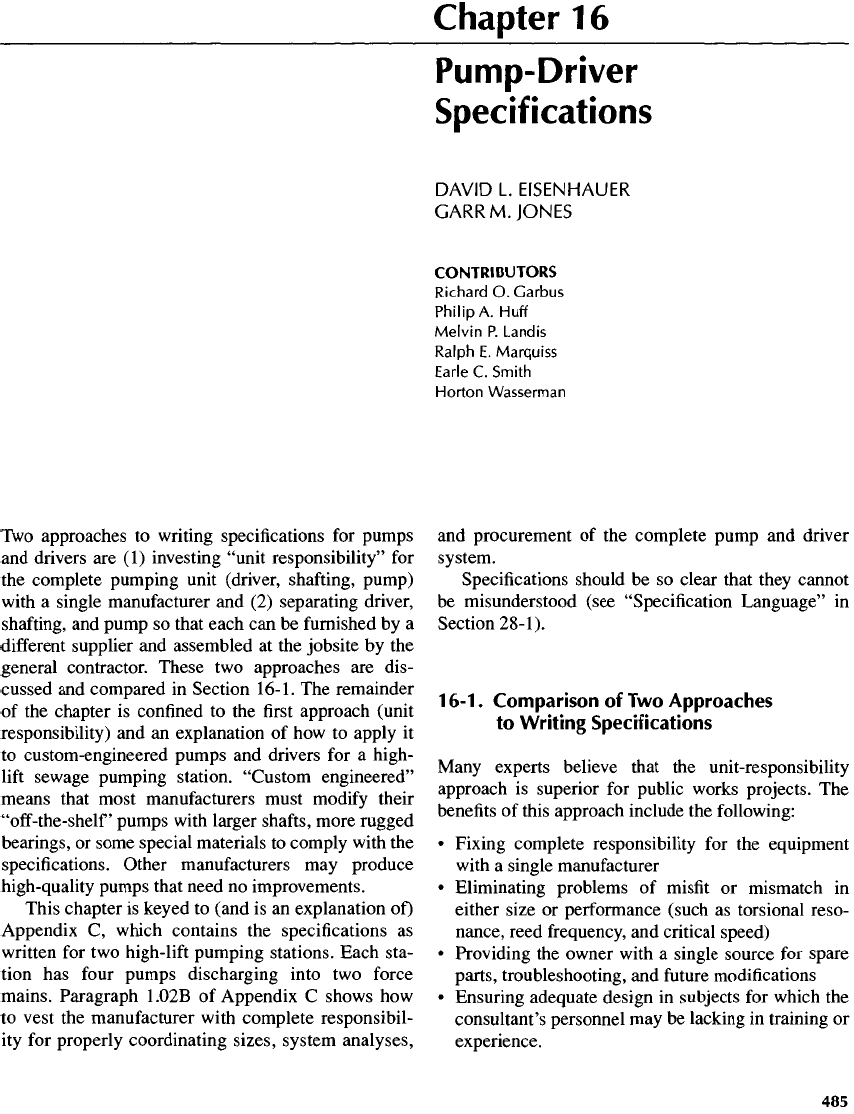
Two
approaches
to
writing specifications
for
pumps
and
drivers
are (1)
investing "unit responsibility"
for
the
complete pumping unit (driver, shafting, pump)
with
a
single manufacturer
and (2)
separating driver,
shafting,
and
pump
so
that each
can be
furnished
by a
different
supplier
and
assembled
at the
jobsite
by the
general contractor. These
two
approaches
are
dis-
cussed
and
compared
in
Section
16-1.
The
remainder
of
the
chapter
is
confined
to the first
approach (unit
responsibility)
and an
explanation
of how to
apply
it
to
custom-engineered pumps
and
drivers
for a
high-
lift
sewage pumping station. "Custom
engineered"
means that most manufacturers must
modify
their
"off-the-shelf
pumps with larger shafts, more rugged
bearings,
or
some special materials
to
comply with
the
specifications.
Other manufacturers
may
produce
high-quality pumps that need
no
improvements.
This chapter
is
keyed
to
(and
is an
explanation
of)
Appendix
C,
which contains
the
specifications
as
written
for two
high-lift
pumping stations. Each sta-
tion
has
four
pumps discharging into
two
force
mains. Paragraph 1.02B
of
Appendix
C
shows
how
to
vest
the
manufacturer with complete
responsibil-
ity
for
properly coordinating sizes, system analyses,
Chapter
1
6
Pump-Driver
Specifications
DAVID
L.
EISENHAUER
GARR
M.
JONES
CONTRIBUTORS
Richard
O.
Garbus
Philip
A.
Huff
Melvin
P.
Landis
Ralph
E.
Marquiss
Earle
C.
Smith
Morton
Wasserman
and
procurement
of the
complete pump
and
driver
system.
Specifications should
be so
clear
that they cannot
be
misunderstood (see
"Specification
Language"
in
Section
28-1).
1
6-1
.
Comparison
of
Two
Approaches
to
Writing Specifications
Many
experts believe that
the
unit-responsibility
approach
is
superior
for
public works projects.
The
benefits
of
this approach include
the
following:
•
Fixing complete responsibility
for the
equipment
with
a
single manufacturer
•
Eliminating problems
of
misfit
or
mismatch
in
either size
or
performance (such
as
torsional
reso-
nance, reed frequency,
and
critical speed)
•
Providing
the
owner with
a
single source
for
spare
parts, troubleshooting,
and
future
modifications
•
Ensuring adequate design
in
subjects
for
which
the
consultant's personnel
may be
lacking
in
training
or
experience.
